-
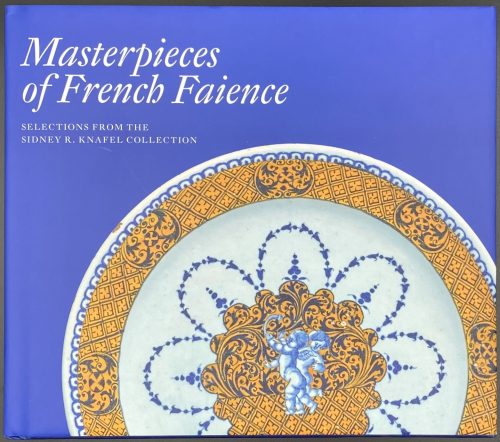 Title: Masterpieces | of French Faience | SELECTIONS FROM THE | SIDNEY R. KNAFEL COLLECTION | Charlotte Vignon | with Sidney R. Knafel | The Frick Collection, New York | in association with D Giles Limited, London | {device} || Pagination: [1-6] 7-72. Contributors: Charlotte Vignon (American, b. c. 1975) – Curator of Decorative Arts at The Frick Collection. Sidney R. Knafel (American, b. c. 1950) – Collector.
Title: Masterpieces | of French Faience | SELECTIONS FROM THE | SIDNEY R. KNAFEL COLLECTION | Charlotte Vignon | with Sidney R. Knafel | The Frick Collection, New York | in association with D Giles Limited, London | {device} || Pagination: [1-6] 7-72. Contributors: Charlotte Vignon (American, b. c. 1975) – Curator of Decorative Arts at The Frick Collection. Sidney R. Knafel (American, b. c. 1950) – Collector. -
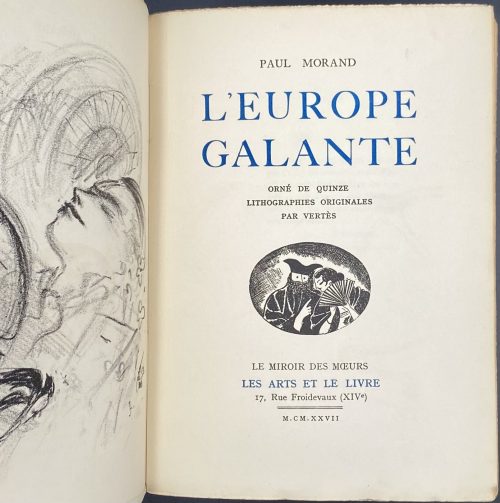 Front wrapper (in black and blue): PAUL MORAND | L'EUROPE | GALANTE | QUINZE LITHOGRAPHES | HORS TEXTE ORIGINALES | DE VERTÈS | {vignette} | LE MIROIR DES MŒURS | LES ARTS ET LE LIVRE | =| M. CM. XXVII || Title-page (in black and blue): PAUL MORAND | L'EUROPE | GALANTE | ORNÉ DE QUINZE | LITHOGRAPHES ORIGINALES | PAR VERTÈS | {vignette} | LE MIROIR DES MŒURS | LES ARTS ET LE LIVRE | 17 Rue Froidevaux (XIVe) | =| M. CM. XXVII || Pagination: [1-9] 10-245 [7], and 2 leaves under the wrappers, ils. Collation: 8vo; [1]8 2-168; first and last leaves under wrappers; total 128 leaves and 17 plates extraneous to collation (two more than the declared 15). Binding: 20.5 x 14.5, French flapped tan wrappers with lettering and vignette, lettering to spine. Printed on May 30, 1927 at l'Imprimerie du Livre, Rueil (Henri Filipacchi, director); under supervision of Georges-Célestin Crès. Edition: 3rd book is the series "Le miroir des mœurs", limited to 1165 copies of which 65 on Papier d'Annam, 15 of them not for sale, numbered 1-50 and 51-65, respectively; 1100 copies on Vélin teinté de Rives (100 of them not for sale), numbered 66-1065 and 1066-1165, respectively. This copy is № 474. Contributors: Paul Morand (French, 1888 – 1976) – author. Marcel Vertès [Marcell Vértes] (Jewish-Hungarian-French, 1895 – 1961) – artist. Les arts et le livre; Georges-Célestin Crès (French, 1875 – 1935) – publisher. l'Imprimerie du Livre (Rueil); Henri Élie Michel Filipacchi [Flippaki] (French, 1900 – 1961) – printer. Other names: Marcel Vertès, Marcel Vertes, Marcell Vértes
Front wrapper (in black and blue): PAUL MORAND | L'EUROPE | GALANTE | QUINZE LITHOGRAPHES | HORS TEXTE ORIGINALES | DE VERTÈS | {vignette} | LE MIROIR DES MŒURS | LES ARTS ET LE LIVRE | =| M. CM. XXVII || Title-page (in black and blue): PAUL MORAND | L'EUROPE | GALANTE | ORNÉ DE QUINZE | LITHOGRAPHES ORIGINALES | PAR VERTÈS | {vignette} | LE MIROIR DES MŒURS | LES ARTS ET LE LIVRE | 17 Rue Froidevaux (XIVe) | =| M. CM. XXVII || Pagination: [1-9] 10-245 [7], and 2 leaves under the wrappers, ils. Collation: 8vo; [1]8 2-168; first and last leaves under wrappers; total 128 leaves and 17 plates extraneous to collation (two more than the declared 15). Binding: 20.5 x 14.5, French flapped tan wrappers with lettering and vignette, lettering to spine. Printed on May 30, 1927 at l'Imprimerie du Livre, Rueil (Henri Filipacchi, director); under supervision of Georges-Célestin Crès. Edition: 3rd book is the series "Le miroir des mœurs", limited to 1165 copies of which 65 on Papier d'Annam, 15 of them not for sale, numbered 1-50 and 51-65, respectively; 1100 copies on Vélin teinté de Rives (100 of them not for sale), numbered 66-1065 and 1066-1165, respectively. This copy is № 474. Contributors: Paul Morand (French, 1888 – 1976) – author. Marcel Vertès [Marcell Vértes] (Jewish-Hungarian-French, 1895 – 1961) – artist. Les arts et le livre; Georges-Célestin Crès (French, 1875 – 1935) – publisher. l'Imprimerie du Livre (Rueil); Henri Élie Michel Filipacchi [Flippaki] (French, 1900 – 1961) – printer. Other names: Marcel Vertès, Marcel Vertes, Marcell Vértes -
![[Maurice Joly]. Dialogue aux Enfers entre Machiavel et Montesquieu ou la politique de Machiavel au XIX eme Siecle, par Un Contemporain.Publisher: Bruxelles, Imprimerie de A. Mertens et Fils, 1864.](https://varshavskycollection.com/wp-content/uploads/2021/02/LIB-1034-d-500x836.jpg) Title page: DIALOGUE AUX ENFERS | ENTRE | MACHIAVEL | ET MONTESQUIEU | OU LA POLITIQUE DE MACHIAVEL | AU XIXe SIÈCLE, | PAR UN CONTEMPORAIN. | {6 lines of citations} | ~ | BRUXELLES, | IMPRIMERIE DE A. MERTENS ET FILS, | RUE DE L’ESCALIER, 22. | 1864 ||
Title page: DIALOGUE AUX ENFERS | ENTRE | MACHIAVEL | ET MONTESQUIEU | OU LA POLITIQUE DE MACHIAVEL | AU XIXe SIÈCLE, | PAR UN CONTEMPORAIN. | {6 lines of citations} | ~ | BRUXELLES, | IMPRIMERIE DE A. MERTENS ET FILS, | RUE DE L’ESCALIER, 22. | 1864 ||Description: 18.5 x 12 cm, quarter red morocco over marbled boards, spine with raised bands ruled blind, gilt lettering, marbled endpapers.
Collation: 12mo; fep, 3 blanks, π4 1-2712, 292, 3 blanks, fep.; total 180 leaves. Pagination: [6] [2 h.t] [2 t.p.] [i] ii-iii [iv] [1] 2-337 [338] [2 errata] [6]. Bookplate to front pastedown: “Le Mis de Biencourt” (probably Mademoiselle Anna Charles de Biencourt). See other copies: LIB-2913.2021 and LIB-0460.2015. Other related objects: SVVP-0062.2021. The publication was funded by the author and smuggled into France. Contributors: Maurice Joly (French, 1829 – 1878) -
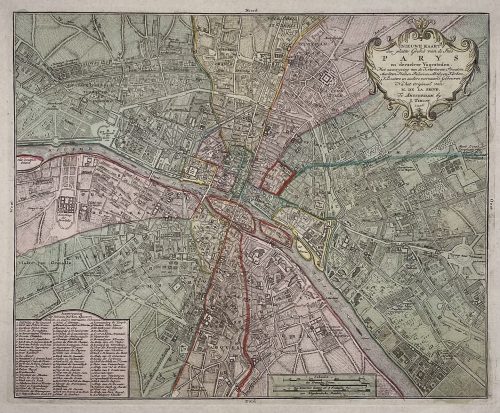
Title: NIEUWE KAART | der platte Grond van de Stad | PARYS | en derzelver Voorsteden. | Met aanwyzing van de Kwartieren, Staaten, | Markten, Pleinen, Paleizen, Abtyden, Kerken, | Kloosters en andere voornaame Gebouwen. | Na het Origineel van | M. DE LA GRIVE. | Te Amsterdam by | I. Tirion. | 1756. ||
Author : Jean Delagrive (French, 1689-1757)
Publisher: Isaak Tirion (Dutch, 1705 – 1765)
Publication date: 1756.
Dimensions: Sheet: 42.5 x 53.8 cm; Image: 30.7 x 37.7 cm.
Plate № 59 from Beknopte Atlas van omtrent honderd platte gronden der voornaamste vestingen, kasteelen en Steden van Europa. -
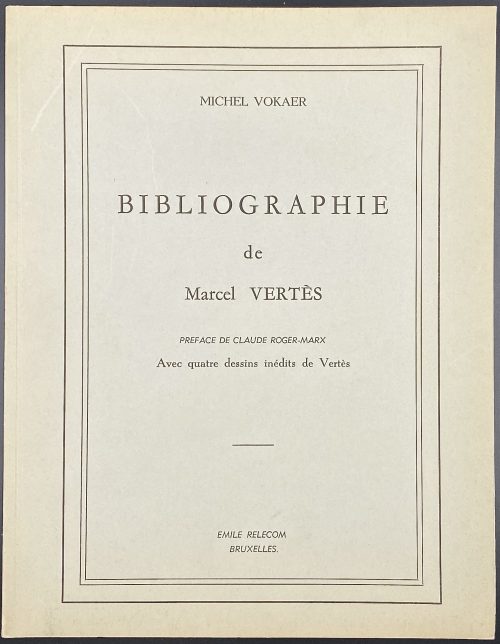 Description: Limited softcover edition in grey publisher’s wrappers 27 x 21 cm, lettered in a frame “MICHEL VOKAER | BIBLIOGRAPHIE | de | Marcel VERTÈS | PREFACE DE CLAUDE ROGER-MARX | Avec quatre dessins inédits de Vertès | — | EMILE RELECOM | BRUXELLES ||, lettered spine, pp. [1-4 h.t., t.p.] 5-34 [35, 36 blanks] [37 limitation] [38 blank] [39 colophon] [40 blank]; 40 pages total plus 4 photomechanical reproductions of Vertès’ unpublished drawings on glossy paper, extraneous to collation. Catalogue of 82 entries. Received uncut. Title-page: similar to front wrapper, plus «1967» in the bottom under BRUXELLES. Limitation: 7 copies (A-G) on Japon chamois + 2 suites of plates, 25 copies (1-25) on Hollande Van Gelder + 1 suite of plates, 450 copies (26-475) on offset Arduenna, and 40 copies not hor sale (I-XL) on different papers. The total print run is 522 copies, of which this is № 206. Ref: leslibraires.fr Contributors: Michel Vokaer (Belgian, 20th century) – author. Claude Roger-Marx (Jewish-French, 1888 – 1977) – author. Marcel Vertès [Marcell Vértes] (Jewish-Hungarian-French, 1895 – 1961) – artist. Xavier Gustave Emile Relecom (Belgian, 1900 – 1977) – publisher.
Description: Limited softcover edition in grey publisher’s wrappers 27 x 21 cm, lettered in a frame “MICHEL VOKAER | BIBLIOGRAPHIE | de | Marcel VERTÈS | PREFACE DE CLAUDE ROGER-MARX | Avec quatre dessins inédits de Vertès | — | EMILE RELECOM | BRUXELLES ||, lettered spine, pp. [1-4 h.t., t.p.] 5-34 [35, 36 blanks] [37 limitation] [38 blank] [39 colophon] [40 blank]; 40 pages total plus 4 photomechanical reproductions of Vertès’ unpublished drawings on glossy paper, extraneous to collation. Catalogue of 82 entries. Received uncut. Title-page: similar to front wrapper, plus «1967» in the bottom under BRUXELLES. Limitation: 7 copies (A-G) on Japon chamois + 2 suites of plates, 25 copies (1-25) on Hollande Van Gelder + 1 suite of plates, 450 copies (26-475) on offset Arduenna, and 40 copies not hor sale (I-XL) on different papers. The total print run is 522 copies, of which this is № 206. Ref: leslibraires.fr Contributors: Michel Vokaer (Belgian, 20th century) – author. Claude Roger-Marx (Jewish-French, 1888 – 1977) – author. Marcel Vertès [Marcell Vértes] (Jewish-Hungarian-French, 1895 – 1961) – artist. Xavier Gustave Emile Relecom (Belgian, 1900 – 1977) – publisher. -
 An uncut fan print showing a young woman checking her makeup in a mirror from the series The pride of Edo [江戸じまん] (Edo jiman). The head portrait in the red circle is of kabuki actor Danjūrō VII. Ichikawa Danjūrō VII [市川団十郎] (Japanese, 1791 – 1859); other names: Ichikawa Ebizō V, Ichikawa Hakuen II, Ichikawa Shinnosuke I. Artist: Utagawa Kunisada [歌川 国貞] a.k.a. Utagawa Toyokuni III [三代 歌川 豊国] (Japanese, 1786 – 1865). Publisher: Ibaya Kyūbei [伊場屋 久兵衛] (Japanese, fl. 1804 – 1851). Artists signature: Ōkō Kunisada ga [應好国貞画] (Drawn to satisfy the taste of Kunisada) Publisher’s seal:久 – Ibakyū [伊場久]. Censor's seal: Kiwame; date seal: Bunsei 10 (1827). Saze: Aiban uchiwa-e; 23.2 x 28.9 cm. Ref.: [LIB-2967.2022] Utagawa Kunisada (1786 – 1865): His world revisited / Catalogue № 17, Exhibition March 17-21, 2021. — NY: Sebastian Izzard, LLC., 2021; p. 102, Cat. 28–fig. a.
An uncut fan print showing a young woman checking her makeup in a mirror from the series The pride of Edo [江戸じまん] (Edo jiman). The head portrait in the red circle is of kabuki actor Danjūrō VII. Ichikawa Danjūrō VII [市川団十郎] (Japanese, 1791 – 1859); other names: Ichikawa Ebizō V, Ichikawa Hakuen II, Ichikawa Shinnosuke I. Artist: Utagawa Kunisada [歌川 国貞] a.k.a. Utagawa Toyokuni III [三代 歌川 豊国] (Japanese, 1786 – 1865). Publisher: Ibaya Kyūbei [伊場屋 久兵衛] (Japanese, fl. 1804 – 1851). Artists signature: Ōkō Kunisada ga [應好国貞画] (Drawn to satisfy the taste of Kunisada) Publisher’s seal:久 – Ibakyū [伊場久]. Censor's seal: Kiwame; date seal: Bunsei 10 (1827). Saze: Aiban uchiwa-e; 23.2 x 28.9 cm. Ref.: [LIB-2967.2022] Utagawa Kunisada (1786 – 1865): His world revisited / Catalogue № 17, Exhibition March 17-21, 2021. — NY: Sebastian Izzard, LLC., 2021; p. 102, Cat. 28–fig. a. -
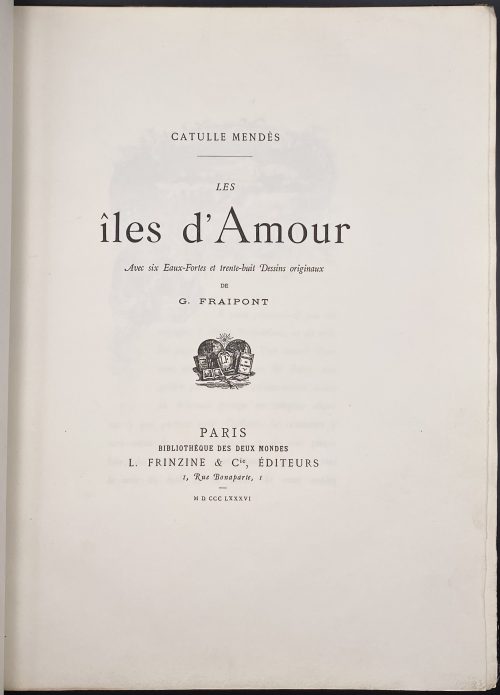 Description: Large volume collated in 4to, 33 x 25 cm, ¾ navy morocco bordered with a gilt double-fillet over marbled boards, raised bands, floral gilt arabesque in compartments, gilt lettering to spine, gilt endpapers, T.E.G. Text printed on wave paper watermarked “Whatman Turkey Mill 1884”; etchings printed on laid paper 32.2 x 24.3 cm, 20 x 13 platemark, 17 x 11 cm image; etched head- and tailpieces, initials. Printed on November 1, 1885. Title-page: CATULLE MENDÈS | — | LES | îles d'Amour | Avec six Eaux-Fortes et trente-huit Dessins originaux | DE | G. FRAIPONT | {publisher’s device} | PARIS | BIBLIOTHÈQUE DES DEUX MONDES | L. FRINZINE & Cie, ÉDITEURS | 1, Rue Bonaparte, 1 | – | M D CCC LXXXVI || Collation: 4to; π4, 1-114 122, total 50 leaves, two binder’s flyleaves in the front and in the back, and 6 plates extraneous to collation. Pagination: [i-v] vi-vii [viii] [1-3] 4-85 [86] [6], total 100 pages, ils. Limitation (printed in red and balck): 1000 copies on vergé (№ 1-1,000), 25 copies on Whatman (№ I-XXV), 15 copies on Japon Impérial (marked A-O). This is copy № III, signed by the publisher. Contributors: Catulle Mendès (French, 1841 – 1909) – author. Gustave Fraipont (Belgian-French, 1849 – 1923) – artist. Charles Unsinger (French, 1823 – 1891) – printer.
Description: Large volume collated in 4to, 33 x 25 cm, ¾ navy morocco bordered with a gilt double-fillet over marbled boards, raised bands, floral gilt arabesque in compartments, gilt lettering to spine, gilt endpapers, T.E.G. Text printed on wave paper watermarked “Whatman Turkey Mill 1884”; etchings printed on laid paper 32.2 x 24.3 cm, 20 x 13 platemark, 17 x 11 cm image; etched head- and tailpieces, initials. Printed on November 1, 1885. Title-page: CATULLE MENDÈS | — | LES | îles d'Amour | Avec six Eaux-Fortes et trente-huit Dessins originaux | DE | G. FRAIPONT | {publisher’s device} | PARIS | BIBLIOTHÈQUE DES DEUX MONDES | L. FRINZINE & Cie, ÉDITEURS | 1, Rue Bonaparte, 1 | – | M D CCC LXXXVI || Collation: 4to; π4, 1-114 122, total 50 leaves, two binder’s flyleaves in the front and in the back, and 6 plates extraneous to collation. Pagination: [i-v] vi-vii [viii] [1-3] 4-85 [86] [6], total 100 pages, ils. Limitation (printed in red and balck): 1000 copies on vergé (№ 1-1,000), 25 copies on Whatman (№ I-XXV), 15 copies on Japon Impérial (marked A-O). This is copy № III, signed by the publisher. Contributors: Catulle Mendès (French, 1841 – 1909) – author. Gustave Fraipont (Belgian-French, 1849 – 1923) – artist. Charles Unsinger (French, 1823 – 1891) – printer. -
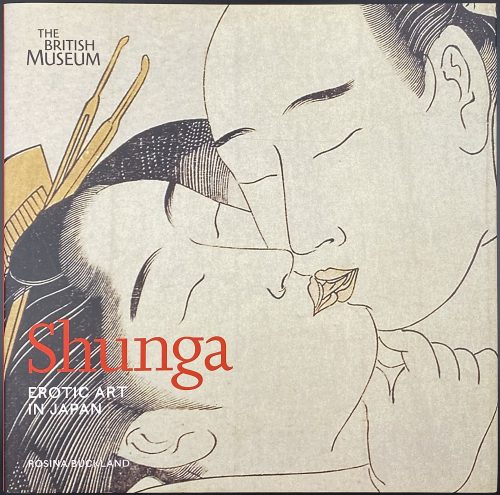 A hardcover pictorial album, 25 x 25.5 cm, bound in black buckram with silver lettering to spine, in pictorial dust jacket; pp.: [1-6] 7-175 [176 blank], total 88 leaves, illustrated in colour throughout. Title-page: Shunga | EROTIC ART | IN JAPAN | ROSINA BUCKLAND | THE BRITISH MUSEUM PRESS || Subject: Art, Japanese – Edo period, 1600-1868; Erotic art – Japan; Prints, Japanese – History. Contributor: Rosina Buckland (British, b. 1974)
A hardcover pictorial album, 25 x 25.5 cm, bound in black buckram with silver lettering to spine, in pictorial dust jacket; pp.: [1-6] 7-175 [176 blank], total 88 leaves, illustrated in colour throughout. Title-page: Shunga | EROTIC ART | IN JAPAN | ROSINA BUCKLAND | THE BRITISH MUSEUM PRESS || Subject: Art, Japanese – Edo period, 1600-1868; Erotic art – Japan; Prints, Japanese – History. Contributor: Rosina Buckland (British, b. 1974) -
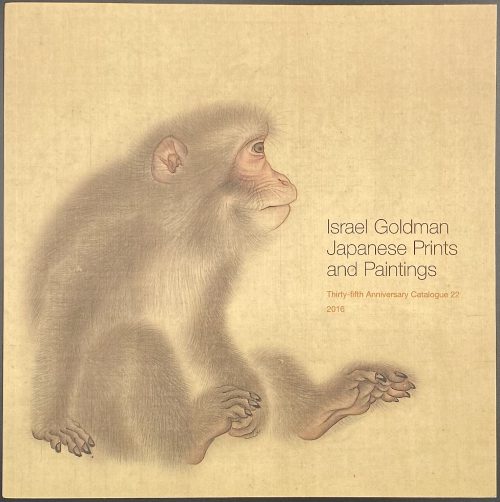 Softcover, pictorial wrappers, square 21 x 21 cm, 42 leaves, unpaginated, with illustrations in colour, 83 entries, with price list laid in; limited edition of 700 copies. Contributor: Israel Goldman In this collection:
Softcover, pictorial wrappers, square 21 x 21 cm, 42 leaves, unpaginated, with illustrations in colour, 83 entries, with price list laid in; limited edition of 700 copies. Contributor: Israel Goldman In this collection: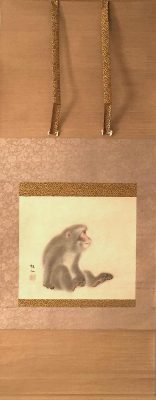
JPD-0010.2016: Mori Sosen. Ink and colour on silk.

JPD-0009.2016: Mori Sosen. Ink and colour on silk.
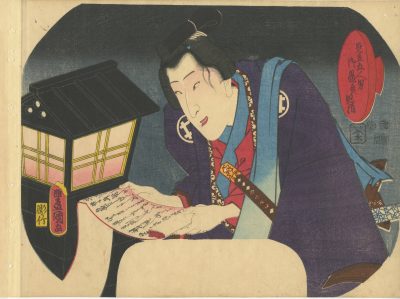
SVJP-0301.2019: Kunisada, 1852. Bando Shuka I as Shirai Gonpachi.
-
 Iron tsuba of round form, slightly convex, decorated with persimmon (kaki), simplified Genji-kō (incense game symbol) and halves of plum blossoms (ume) in brass inlay on both sides, and with part of bellflower (kikyo) in openwork. Outer rim, seppa-dai, bellflower openwork, and kozuka-ana outlined with brass inlay; traces of lacquer to surface. The symbolic meaning alludes to Chapter 20: Asagao (朝顔, the bellflower or "morning face") of Tale of Genji by Murasaki Shikibu (11th century AD). The events take place in the 9th lunar month (Nagatsuki) and involve the following poetry by Prince Genji: saku hana ni / utsuru chō na wa / tsutsumedomo / orade sugiuki / kesa no asagao [I would not have it said / that my heart has turned toward / a flower in bloom — / yet how hard it is to pass / without plucking a “morning face”!]. Measurements: H: 76.6 mm; W: 76.3 mm; Th.: 3.6 mm (seppa-dai), 3.0 mm (rim) Time: Late Muromachi (1514 – 1573).
Iron tsuba of round form, slightly convex, decorated with persimmon (kaki), simplified Genji-kō (incense game symbol) and halves of plum blossoms (ume) in brass inlay on both sides, and with part of bellflower (kikyo) in openwork. Outer rim, seppa-dai, bellflower openwork, and kozuka-ana outlined with brass inlay; traces of lacquer to surface. The symbolic meaning alludes to Chapter 20: Asagao (朝顔, the bellflower or "morning face") of Tale of Genji by Murasaki Shikibu (11th century AD). The events take place in the 9th lunar month (Nagatsuki) and involve the following poetry by Prince Genji: saku hana ni / utsuru chō na wa / tsutsumedomo / orade sugiuki / kesa no asagao [I would not have it said / that my heart has turned toward / a flower in bloom — / yet how hard it is to pass / without plucking a “morning face”!]. Measurements: H: 76.6 mm; W: 76.3 mm; Th.: 3.6 mm (seppa-dai), 3.0 mm (rim) Time: Late Muromachi (1514 – 1573). -
 Iron tsuba of the round form (maru gata) with a grey patina pierced with the design of slanting rays of light (Jesuit’s IHS symbol) and a pair of ginger symbols [茗荷] (myōga) at top and bottom, in positive silhouette (ji-sukashi). This design is often called “tokei” [時計] or “clock gear”. Rounded rim, large hitsu-ana, copper fittings (sekigane). Unsigned, unpapered. Owari school. Early Edo period, early 17th century.
Iron tsuba of the round form (maru gata) with a grey patina pierced with the design of slanting rays of light (Jesuit’s IHS symbol) and a pair of ginger symbols [茗荷] (myōga) at top and bottom, in positive silhouette (ji-sukashi). This design is often called “tokei” [時計] or “clock gear”. Rounded rim, large hitsu-ana, copper fittings (sekigane). Unsigned, unpapered. Owari school. Early Edo period, early 17th century.Size: H 71.9 x W 71.1 x Th (centre) 5.5 cm.
For information regarding this type of tsuba see the article 'Kirishitan Ikenie Tsuba by Fred Geyer at Kokusai Tosogu Kai; The 2nd International Convention & Exhibition, October 18-23, 2006, pp. 84-91. 
IHS emblem of the Jesuits

茗荷 Myoga or Japanese ginger
-
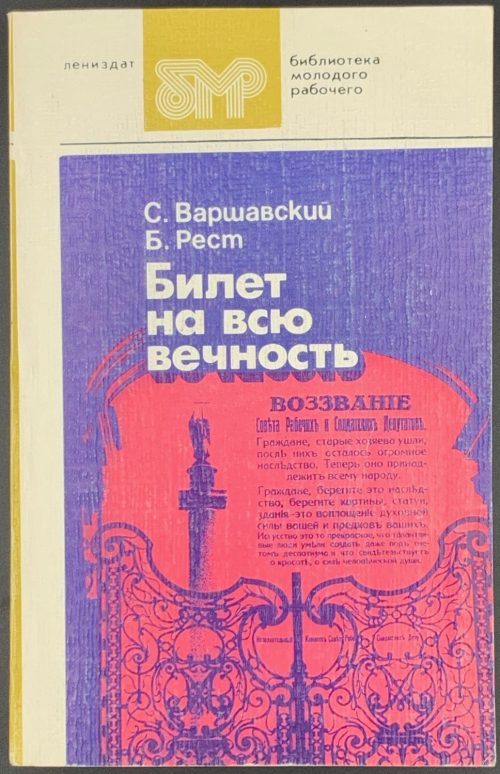 A book about the history and collections of The Hermitage museum in St. Petersburg during the October revolution of 1917. Paperback, 20 x 12.5 cm, 16mo, serial pictorial wrappers, blurb to rear; [1]-716 88( plates, not paginated) 9-1016; pp.: [2] 3-260 [4]: 264 pages + 16 pages of plates, not paginated, 152 leaves, incl. plates. Library pocket and card to front wrapper verso. Ink stamp of the Hermitage museum library. Title-page: «БМР» device // библиотека | молодого | рабочего | — | С. ВАРШАВСКИЙ | Б. РЕСТ | БИЛЕТ | НА ВСЮ | ВЕЧНОСТЬ | ПОВЕСТЬ ОБ ЭРМИТАЖЕ | В ТРЕХ ЧАСТЯХ | ЧАСТИ ПЕРВАЯ И ВТОРАЯ | ЛЕНИЗДАТ • 1986 || Sergei Petrovich Varshavsky [Сергей Петрович Варшавский] (Jewish-Russian, 1906 – 1980). B. Rest [Б. Рест; Юлий Исаакович Шапиро] (Jewish-Russian, fl. 1940 – 1980). Preface: Boris Piotrovsky [Борис Борисович Пиотровский] (Russian, 1908 – 1990).
A book about the history and collections of The Hermitage museum in St. Petersburg during the October revolution of 1917. Paperback, 20 x 12.5 cm, 16mo, serial pictorial wrappers, blurb to rear; [1]-716 88( plates, not paginated) 9-1016; pp.: [2] 3-260 [4]: 264 pages + 16 pages of plates, not paginated, 152 leaves, incl. plates. Library pocket and card to front wrapper verso. Ink stamp of the Hermitage museum library. Title-page: «БМР» device // библиотека | молодого | рабочего | — | С. ВАРШАВСКИЙ | Б. РЕСТ | БИЛЕТ | НА ВСЮ | ВЕЧНОСТЬ | ПОВЕСТЬ ОБ ЭРМИТАЖЕ | В ТРЕХ ЧАСТЯХ | ЧАСТИ ПЕРВАЯ И ВТОРАЯ | ЛЕНИЗДАТ • 1986 || Sergei Petrovich Varshavsky [Сергей Петрович Варшавский] (Jewish-Russian, 1906 – 1980). B. Rest [Б. Рест; Юлий Исаакович Шапиро] (Jewish-Russian, fl. 1940 – 1980). Preface: Boris Piotrovsky [Борис Борисович Пиотровский] (Russian, 1908 – 1990). -
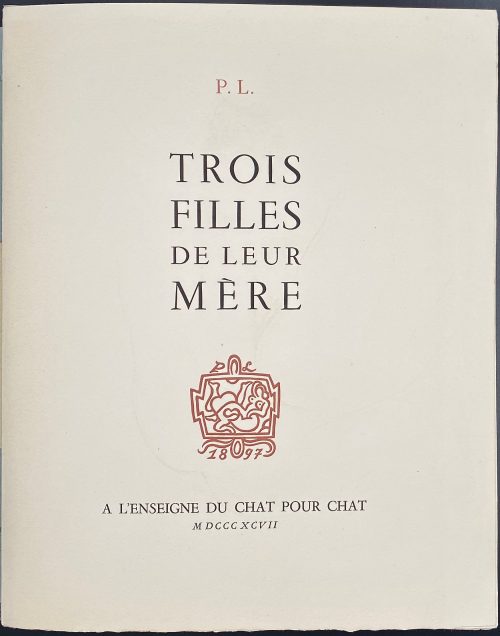 Description: Softcover, original blue-grey wrappers, maroon fleuron to front wrapper « P.L. {copulating couple} 1897. », 28.5 x 23 cm, in a grey double slipcase. Pp.: [1-10] 11-192 [2] [6 blanks], total 200 pages, 50 folio leaves folded in half collated in 4to, unbound, plus 16 coloured lithographs by Jean Berque; all printed on wove paper watermarked “LANA”. This is № 207 of an undisclosed number of copies. Edition enriched with a suite of 12 hand-coloured etchings after Éduard Chimot for publication in the late 1940s (Dutel 2524) on BFK Rives paper. Title-page (maroon and black): P. L. | TROIS | FILLES | DE LEUR | MÈRE | {fleuron} | A L'ENSEIGNE DU CHAT POUR CHAT | M DCCC XCVII || Catalogue raisonné: Dutel 2523, Pia 1340. Contributors: Pierre Louÿs (French, 1870 – 1925) – author. Jean Berque (French, 1896 – 1954) – artist. Édouard Chimot (French, 1880 – 1959) – artist.
Description: Softcover, original blue-grey wrappers, maroon fleuron to front wrapper « P.L. {copulating couple} 1897. », 28.5 x 23 cm, in a grey double slipcase. Pp.: [1-10] 11-192 [2] [6 blanks], total 200 pages, 50 folio leaves folded in half collated in 4to, unbound, plus 16 coloured lithographs by Jean Berque; all printed on wove paper watermarked “LANA”. This is № 207 of an undisclosed number of copies. Edition enriched with a suite of 12 hand-coloured etchings after Éduard Chimot for publication in the late 1940s (Dutel 2524) on BFK Rives paper. Title-page (maroon and black): P. L. | TROIS | FILLES | DE LEUR | MÈRE | {fleuron} | A L'ENSEIGNE DU CHAT POUR CHAT | M DCCC XCVII || Catalogue raisonné: Dutel 2523, Pia 1340. Contributors: Pierre Louÿs (French, 1870 – 1925) – author. Jean Berque (French, 1896 – 1954) – artist. Édouard Chimot (French, 1880 – 1959) – artist. -
 Artist: Utagawa Kunisada [歌川 国貞] a.k.a. Utagawa Toyokuni III [三代歌川豊国] (Japanese, 1786 – 1865). Pubisher (accorfding to Suzuki & Oka): Ibaya Senzaburō [伊場屋仙三郎] (Japanese, 1815 – 1869), Dansendō [伊場仙]. Title: Beauty holding a roll of paper (by seller); A woman of Edo (by Suzuki & Oka) Date seal and aratame censor seal: 1822 (Bunsei 5). Signed: Gototei Kunisada ga [五渡亭国貞画]. Media: Untrimmed fan print (uchiwa-e), 228 x 295 mm. Ref: [LIB-3085.2022] Jūzō Suzuki, Isaburō Oka. “The decadents”. — Tokyo: Kodansha International, 1969, p. 35, plate 30: exactly this print:
Artist: Utagawa Kunisada [歌川 国貞] a.k.a. Utagawa Toyokuni III [三代歌川豊国] (Japanese, 1786 – 1865). Pubisher (accorfding to Suzuki & Oka): Ibaya Senzaburō [伊場屋仙三郎] (Japanese, 1815 – 1869), Dansendō [伊場仙]. Title: Beauty holding a roll of paper (by seller); A woman of Edo (by Suzuki & Oka) Date seal and aratame censor seal: 1822 (Bunsei 5). Signed: Gototei Kunisada ga [五渡亭国貞画]. Media: Untrimmed fan print (uchiwa-e), 228 x 295 mm. Ref: [LIB-3085.2022] Jūzō Suzuki, Isaburō Oka. “The decadents”. — Tokyo: Kodansha International, 1969, p. 35, plate 30: exactly this print:
-
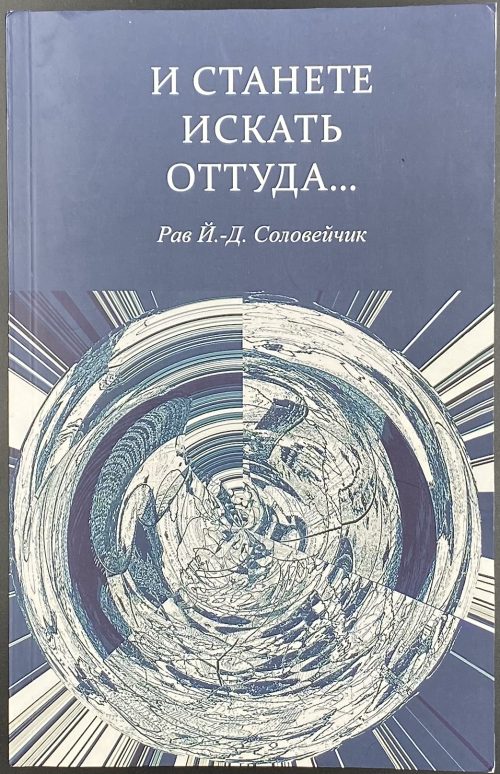 Paperback, 21.2 x 13.6 cm, dark blue pictorial covers with white lettering, pp.: [2] 3-316 [4]. Title-page: Рав. Й.-Д. Соловейчик | И СТАНЕТЕ ИСКАТЬ | ОТТУДА… | Перевод Мириам Китросской | Памяти | Миши Шнейдера и Лены Гальпериной | {publisher’s device} | Иерусалим 5782 (2022) || Contributors: Иосеф Дов-Бер ха-Леви Соловейчик [יוסף דב הלוי סולובייצ'יק, Joseph Dov-Ber Soloveitchik) (Jewish-American, 1903 – 1993) Мириам Китросская [Miriam Kitrossky] (Israeli, b. 1957)
Paperback, 21.2 x 13.6 cm, dark blue pictorial covers with white lettering, pp.: [2] 3-316 [4]. Title-page: Рав. Й.-Д. Соловейчик | И СТАНЕТЕ ИСКАТЬ | ОТТУДА… | Перевод Мириам Китросской | Памяти | Миши Шнейдера и Лены Гальпериной | {publisher’s device} | Иерусалим 5782 (2022) || Contributors: Иосеф Дов-Бер ха-Леви Соловейчик [יוסף דב הלוי סולובייצ'יק, Joseph Dov-Ber Soloveitchik) (Jewish-American, 1903 – 1993) Мириам Китросская [Miriam Kitrossky] (Israeli, b. 1957) -
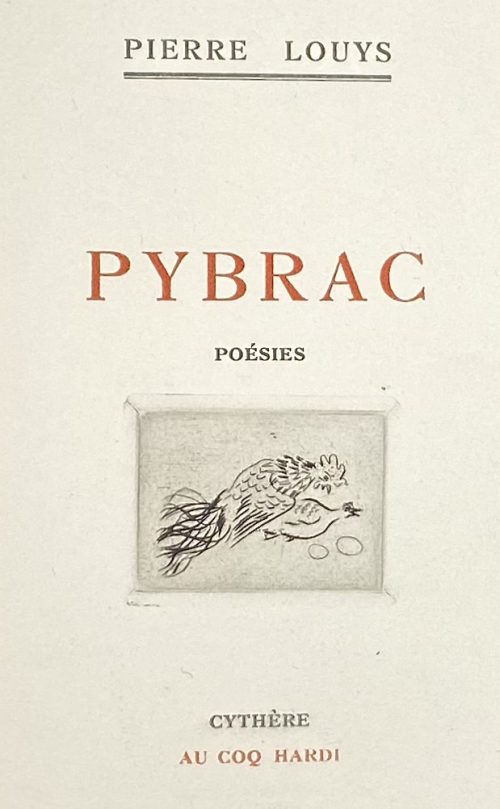 Description: Softcover, French flapped wrappers, 19.7 x 14.5 cm, printed on thick wove paper watermarked “J. PERRIGOT ARCHES MBM”; engraved vignette by Foujita to t.p.; some pages towards the end uncut. Illustrated by ten original watercolours, unsigned. Collation: Pink wrappers, lettered to front, in frame: “P. L. |—| PYBRAC |—| 1927”, 2 blank leaves (one in wrapper), [2] h.t./blank, [2] t.p. in red and black with engraved vignette by Foujita / blank, [2] (Sur la chemise...), [2] f.t. / watercolour on reverse, [5] 6-98 [2 colophon/blank], 2 blank leaves (one in wrapper). Title-page (red and black): PIERRE LOUŸS | PYBRAC | POESIES | {vignette} | CYTHÈRE | AU COQ HARDI || Edition: Limited edition of 105 copies, of which this is copy № 28 on Arches paper, unique as enhanced with 10 colour drawings by an anonymous artist, presumably by Feodor Rojankovsky (dit Rojan), a unique copy. Cat. raisonné: Dutel III № 2278 p. 334; Dutel describes two unique copies of the edition, one with 6 and another with 24 original watercolours by Rojan. Contributors: Pierre Louÿs (French, 1870 – 1925) – author. Léonard Tsuguharu Foujita (Japanese-French, 1886 – 1968) – artist (t.p. vignette). Feodor Rojankovsky [Rojan, Фёдор Степанович Рожанковский] (Russian-American, 1891 – 1970). René Bonnel (French, 1884 – 1975) – publisher. Another unique copy of the same edition illustrated by an anonymous artist in this collection LIB-3061.2022.
Description: Softcover, French flapped wrappers, 19.7 x 14.5 cm, printed on thick wove paper watermarked “J. PERRIGOT ARCHES MBM”; engraved vignette by Foujita to t.p.; some pages towards the end uncut. Illustrated by ten original watercolours, unsigned. Collation: Pink wrappers, lettered to front, in frame: “P. L. |—| PYBRAC |—| 1927”, 2 blank leaves (one in wrapper), [2] h.t./blank, [2] t.p. in red and black with engraved vignette by Foujita / blank, [2] (Sur la chemise...), [2] f.t. / watercolour on reverse, [5] 6-98 [2 colophon/blank], 2 blank leaves (one in wrapper). Title-page (red and black): PIERRE LOUŸS | PYBRAC | POESIES | {vignette} | CYTHÈRE | AU COQ HARDI || Edition: Limited edition of 105 copies, of which this is copy № 28 on Arches paper, unique as enhanced with 10 colour drawings by an anonymous artist, presumably by Feodor Rojankovsky (dit Rojan), a unique copy. Cat. raisonné: Dutel III № 2278 p. 334; Dutel describes two unique copies of the edition, one with 6 and another with 24 original watercolours by Rojan. Contributors: Pierre Louÿs (French, 1870 – 1925) – author. Léonard Tsuguharu Foujita (Japanese-French, 1886 – 1968) – artist (t.p. vignette). Feodor Rojankovsky [Rojan, Фёдор Степанович Рожанковский] (Russian-American, 1891 – 1970). René Bonnel (French, 1884 – 1975) – publisher. Another unique copy of the same edition illustrated by an anonymous artist in this collection LIB-3061.2022. -
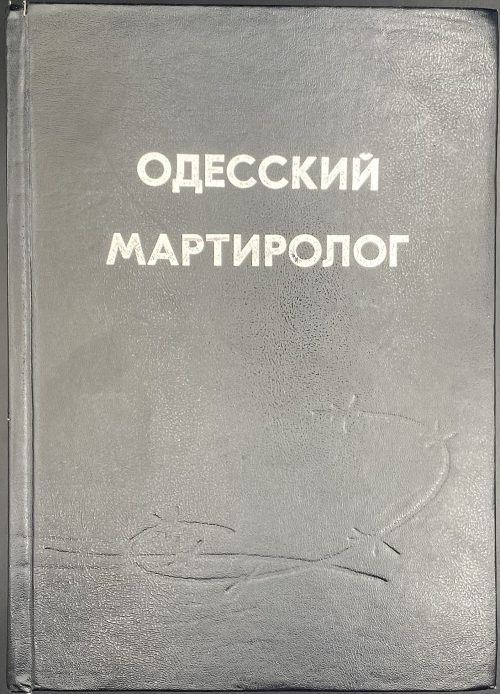 Hardcover volume, 24.5 x 17.5 cm, bound in black buckram with blind barbed wire design and silver lettering to front cover and spine, pp.: [2] 3-799 [800]. Одеський мартиролог: Данi про репресованих Одеси i Одеськоï областi за роки радянськоï влады (Серiя «Реабiлiтованi iсторiэю») (Том 2) / Уклад.: Л. В. Ковальчук, Г. О. Разумов— Одеса : ОКФА, 1999. Title-page: Научно-документальная серия книг | «РЕАБИЛИТИРОВАННЫЕ ИСТОРИЕЙ» | ОДЕССКИЙ | МАРТИРОЛОГ | ТОМ 2 | Одесса | ОКФА | 1999 || ISBN: 966-571-035-4 Print run: 1,000 copies. Ковальчук, Лидия Всеволодовна Разумов, Георгий Александрович
Hardcover volume, 24.5 x 17.5 cm, bound in black buckram with blind barbed wire design and silver lettering to front cover and spine, pp.: [2] 3-799 [800]. Одеський мартиролог: Данi про репресованих Одеси i Одеськоï областi за роки радянськоï влады (Серiя «Реабiлiтованi iсторiэю») (Том 2) / Уклад.: Л. В. Ковальчук, Г. О. Разумов— Одеса : ОКФА, 1999. Title-page: Научно-документальная серия книг | «РЕАБИЛИТИРОВАННЫЕ ИСТОРИЕЙ» | ОДЕССКИЙ | МАРТИРОЛОГ | ТОМ 2 | Одесса | ОКФА | 1999 || ISBN: 966-571-035-4 Print run: 1,000 copies. Ковальчук, Лидия Всеволодовна Разумов, Георгий АлександровичPages 515-531. 13. Постановление помощника уполномоченного Одесского окружного отдела ГПУ Найдмана по делу сотрудников Индо-Европейского телеграфа, репрессированных в 1927 г. по обвинению в шпионаже. […] ВАРШАВСКОЙ Эльзы Филипповны, 45 лет, уроженицы г. Одессы, по национальности – еврейка, происходит из купеческой семьи, подданства УССР, образования среднего, замужняя, не судившаяся, беспартийная, в союзе не состоит, без профессии, проживавшая по ул. Хмельницкого в д. № 18, в совершении преступлений, предусмотренных ст. 54-6 УК УССР, нашел: […] Note: ст. 54-6 — шпигунство: позбавлення волі на строк не менш як 3 роки, з конфіскацією всього або частини майна, аж до вищого заходу соціального захисту — розстрілу.
-
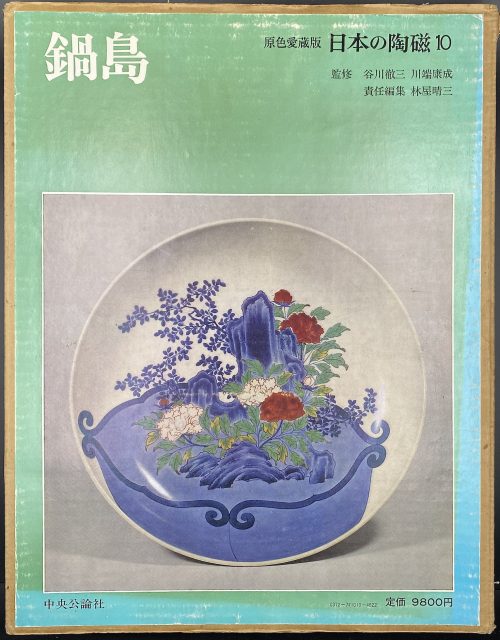 Hardcover volume, 35 x 26.8 cm, bound in grey cloth, blind stamped characters to front, brown characters to spine, in a double slipcase, the outer case pictorial paper over cardboard, 36 x 28.2 cm, pp.: [4] [1] 2-144 (plates with photographs of 332 items), [2] 147-182 [4]. 鍋島 – Nabeshima – book title. 日本の陶磁 – Japanese ceramics, series title. Contributors: Yasunari Kawabata [川端 康成] (Japanese, 1924 – 1972) – author. Tetsuzo Tanikawa [谷川 徹三] (Japanese, 1895 – 1989) – author. Seizo Hayashiya [林屋晴三] (Japanese, 1928 – 2017) – editor. Chūōkōron-sha [中央公論社] – publisher.
Hardcover volume, 35 x 26.8 cm, bound in grey cloth, blind stamped characters to front, brown characters to spine, in a double slipcase, the outer case pictorial paper over cardboard, 36 x 28.2 cm, pp.: [4] [1] 2-144 (plates with photographs of 332 items), [2] 147-182 [4]. 鍋島 – Nabeshima – book title. 日本の陶磁 – Japanese ceramics, series title. Contributors: Yasunari Kawabata [川端 康成] (Japanese, 1924 – 1972) – author. Tetsuzo Tanikawa [谷川 徹三] (Japanese, 1895 – 1989) – author. Seizo Hayashiya [林屋晴三] (Japanese, 1928 – 2017) – editor. Chūōkōron-sha [中央公論社] – publisher. -
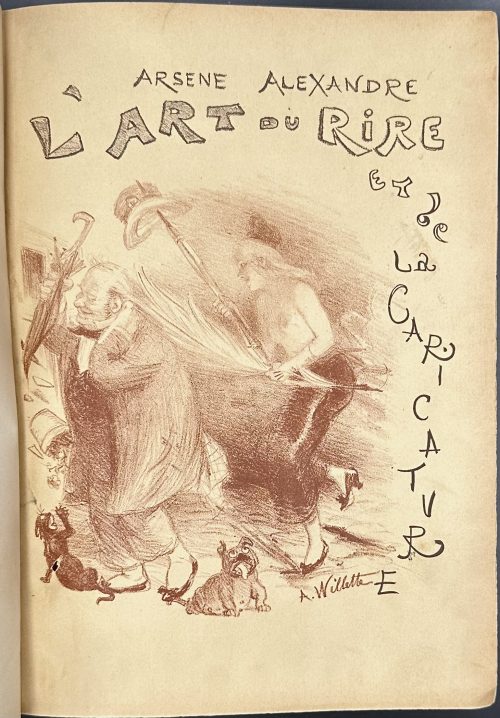 Hardcover volume 28.5 x 20.8 cm, quarter brown morocco over marbled boards, ruled in gilt, spine with raised bands, gilt in compartments, gilt lettering, marbled endpapers, top margin gilt, original lithographic wrappers designed by A. Willette preserved; pp.: [4] h.t., t.p., [1] 2-350 [2], 300 b/w ils in-text and 12 coloured photomechanical reproductions extraneous to collation; collated in-4o: π2 1-444; Title-page: L'ART DU RIRE | ET DE | LA CARICATURE | PAR ARSÈNE ALEXANDRE | 300 FAC-SIMILÉS EN NOIR ET 12 PLANCHES EN COULEURS | D’APRÈS LES ORIGINAUX | {vignette} | PARIS | ANCIENNE MAISON QUANIN | LIBRAIRIES-IMPRIMERIES RÉUNIES | 7, RUE ST-BENOIT | MAY & MOTTEROZ, DIRECTEURS || Contributors : Librairie-Imprimerie réunies (Paris, 1880-1908) – publisher. Arsène Alexandre (French, 1859 – 1937) – author. Adolphe Willette (French, 1857 – 1926) – artist (wrapper)
Hardcover volume 28.5 x 20.8 cm, quarter brown morocco over marbled boards, ruled in gilt, spine with raised bands, gilt in compartments, gilt lettering, marbled endpapers, top margin gilt, original lithographic wrappers designed by A. Willette preserved; pp.: [4] h.t., t.p., [1] 2-350 [2], 300 b/w ils in-text and 12 coloured photomechanical reproductions extraneous to collation; collated in-4o: π2 1-444; Title-page: L'ART DU RIRE | ET DE | LA CARICATURE | PAR ARSÈNE ALEXANDRE | 300 FAC-SIMILÉS EN NOIR ET 12 PLANCHES EN COULEURS | D’APRÈS LES ORIGINAUX | {vignette} | PARIS | ANCIENNE MAISON QUANIN | LIBRAIRIES-IMPRIMERIES RÉUNIES | 7, RUE ST-BENOIT | MAY & MOTTEROZ, DIRECTEURS || Contributors : Librairie-Imprimerie réunies (Paris, 1880-1908) – publisher. Arsène Alexandre (French, 1859 – 1937) – author. Adolphe Willette (French, 1857 – 1926) – artist (wrapper) -
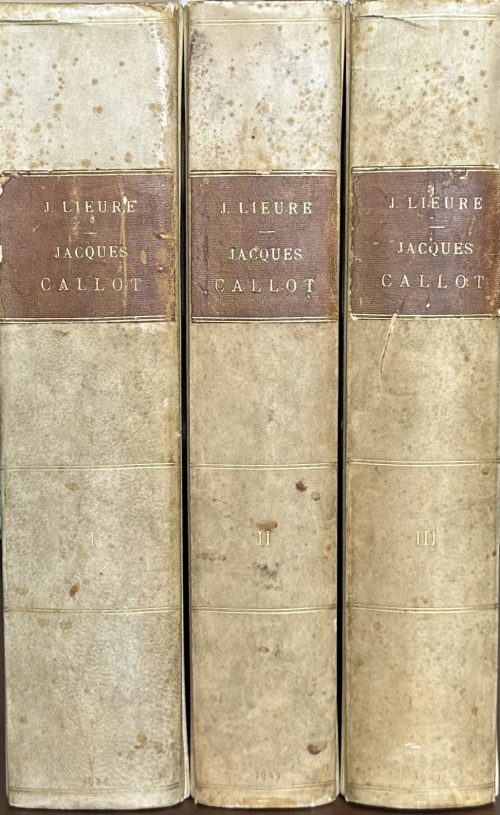 Three volumes, 33 x 26.5 x 7 cm each, uniformly bound in 2/3 vellum over marbled boards, outlined with gilt fillet, brown label with gilt lettering to flat spine with double fillet faux-bands, marbled endpapers, top edge gilt, other untrimmed, publisher’s wrappers preserved, incl. spine; collotype plates with captioned glassine guards; armorial bookplate of Comte Alain de Suzannet to front pastedown in each volume. Two volumes of Première partie, wanting, contain La vie artistique : texte and La vie artistique : planches. Title-page (red and black): JACQUES CALLOT | PAR | J. LIEURE | Introduction de F. Courboin | Conservateur du Cabinet des Estampes à la Bibliothèque Nationale | — | DEUXIÈME PARTIE | CATALOGUE DE L’ŒUVRE GRAVÉ | TOME I (II, III) | — | PARIS | ÉDITIONS DE LA GAZETTE DES BEAUX-ARTS | 106, Boulevard Saint-Germain (6e) | 1924 (1927, 1927) || Vol. 1 (1924): [4] [1] 2-122 [2], wrappers, plates 1-299; printed on September 15, 1924, by André Lesot (Nemours) and D. Jacomet et Cie (Paris). Vol. 2 (1927): [4] [1] 2-106 [2], wrappers, plates 300-652. Vol. 3 (1927): [4] [1] 2-128 [4], wrappers, plates 653-1428; printed on September 5, 1926, by Imprimerie moderne des Beaux-Arts (Bois-Colombes) and D. Jacomet et Cie (Paris). Contributors: Jules Lieure (French, 1866 – 1948) – author. Jacques Callot (French, c. 1592 – 1635) – artist. Gazette des Beaux-Arts (f. 1859) – publisher. François Courboin (French, 1865 – 1926) – author. D. Jacomet et Cie (Paris) – printer. Daniel Jacomet (French, 1894 – 1966) – printer. André Lesot (French, 1874-1951) – printer. Imprimerie moderne des Beaux-Arts (Bois-Colombes) Comte Alain de Suzannet (French, 1882 – 1950) – provenance.
Three volumes, 33 x 26.5 x 7 cm each, uniformly bound in 2/3 vellum over marbled boards, outlined with gilt fillet, brown label with gilt lettering to flat spine with double fillet faux-bands, marbled endpapers, top edge gilt, other untrimmed, publisher’s wrappers preserved, incl. spine; collotype plates with captioned glassine guards; armorial bookplate of Comte Alain de Suzannet to front pastedown in each volume. Two volumes of Première partie, wanting, contain La vie artistique : texte and La vie artistique : planches. Title-page (red and black): JACQUES CALLOT | PAR | J. LIEURE | Introduction de F. Courboin | Conservateur du Cabinet des Estampes à la Bibliothèque Nationale | — | DEUXIÈME PARTIE | CATALOGUE DE L’ŒUVRE GRAVÉ | TOME I (II, III) | — | PARIS | ÉDITIONS DE LA GAZETTE DES BEAUX-ARTS | 106, Boulevard Saint-Germain (6e) | 1924 (1927, 1927) || Vol. 1 (1924): [4] [1] 2-122 [2], wrappers, plates 1-299; printed on September 15, 1924, by André Lesot (Nemours) and D. Jacomet et Cie (Paris). Vol. 2 (1927): [4] [1] 2-106 [2], wrappers, plates 300-652. Vol. 3 (1927): [4] [1] 2-128 [4], wrappers, plates 653-1428; printed on September 5, 1926, by Imprimerie moderne des Beaux-Arts (Bois-Colombes) and D. Jacomet et Cie (Paris). Contributors: Jules Lieure (French, 1866 – 1948) – author. Jacques Callot (French, c. 1592 – 1635) – artist. Gazette des Beaux-Arts (f. 1859) – publisher. François Courboin (French, 1865 – 1926) – author. D. Jacomet et Cie (Paris) – printer. Daniel Jacomet (French, 1894 – 1966) – printer. André Lesot (French, 1874-1951) – printer. Imprimerie moderne des Beaux-Arts (Bois-Colombes) Comte Alain de Suzannet (French, 1882 – 1950) – provenance. -
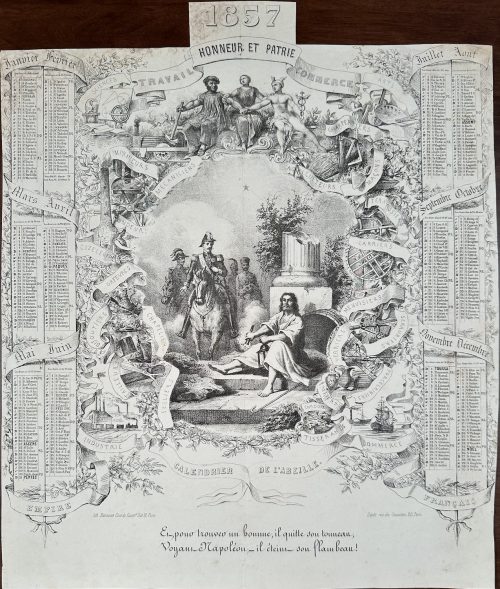 Lithography and etching on wove paper432 x 362 mm, black ink stamp “5022” to reverse, horizontal and vertical centrefolds. Depicts Diogenes (Ancient Greek, 412/404 – 323 BC) beside his barrel and extinguishing his torch when approached by Napoléon III ahorseback. Top: "1857 | HONNEUR ET PATRIE"; lettering on ribbons (top-down): SCIENCES, TRAVAIL, COMMERCE, ARTS, CHARPENTIERS, IMPRIMEURS, "MECHANICIENS, AGRICULTEURS, MAÇONS, FONDEURS, TERRASIERS, CIZELEURS, CARRIERS, ORFEVRES, BIJOUTIERS, CHAPELIERS, MENUISIERS, VERRIERS, SERRURIERS, TAILLEURS, SELLIERS, POTIERS, PORCELAINIERS, CORDONNIERS, TISSERANDS, INDUSTRIE, COMMERCE | CALENDRIER DE L'ABEILLE | EMPIRE, FRANÇAIS. Below left: "lith. Barousse Cour du Comm. 11 et 12. Paris"; right: "Dépôt rue des Cannettes, 20. Paris"; bottom: "Et, pour trouver un homme, il quitte son tonneau, | Voyant Napoléon, – il éteint son flambeau!" [And, to find a man, he leaves his barrel, | Seeing Napoleon, – he extinguishes his torch!]. Six months on the left and six months on the right-hand side of the calendar, surrounding the image.
Lithography and etching on wove paper432 x 362 mm, black ink stamp “5022” to reverse, horizontal and vertical centrefolds. Depicts Diogenes (Ancient Greek, 412/404 – 323 BC) beside his barrel and extinguishing his torch when approached by Napoléon III ahorseback. Top: "1857 | HONNEUR ET PATRIE"; lettering on ribbons (top-down): SCIENCES, TRAVAIL, COMMERCE, ARTS, CHARPENTIERS, IMPRIMEURS, "MECHANICIENS, AGRICULTEURS, MAÇONS, FONDEURS, TERRASIERS, CIZELEURS, CARRIERS, ORFEVRES, BIJOUTIERS, CHAPELIERS, MENUISIERS, VERRIERS, SERRURIERS, TAILLEURS, SELLIERS, POTIERS, PORCELAINIERS, CORDONNIERS, TISSERANDS, INDUSTRIE, COMMERCE | CALENDRIER DE L'ABEILLE | EMPIRE, FRANÇAIS. Below left: "lith. Barousse Cour du Comm. 11 et 12. Paris"; right: "Dépôt rue des Cannettes, 20. Paris"; bottom: "Et, pour trouver un homme, il quitte son tonneau, | Voyant Napoléon, – il éteint son flambeau!" [And, to find a man, he leaves his barrel, | Seeing Napoleon, – he extinguishes his torch!]. Six months on the left and six months on the right-hand side of the calendar, surrounding the image. -
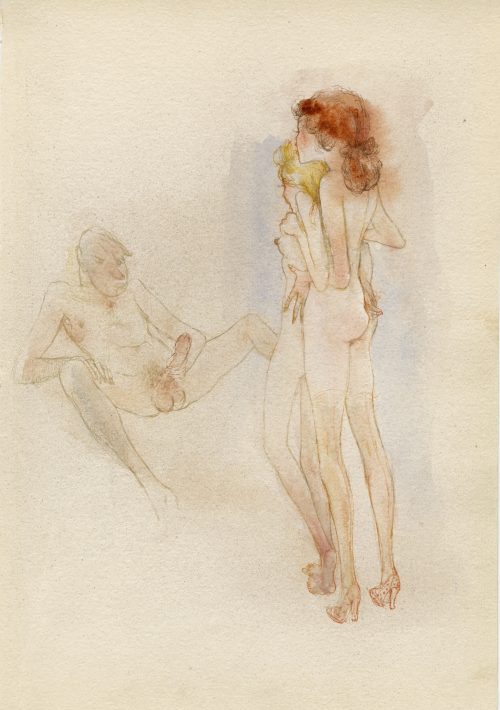 Watercolour on thick wove paper, unsigned. Attributed to Otto Rudolf Schatz (Austrian, 1900 – 1961). Size: 305 x 212 mm.
Watercolour on thick wove paper, unsigned. Attributed to Otto Rudolf Schatz (Austrian, 1900 – 1961). Size: 305 x 212 mm. -
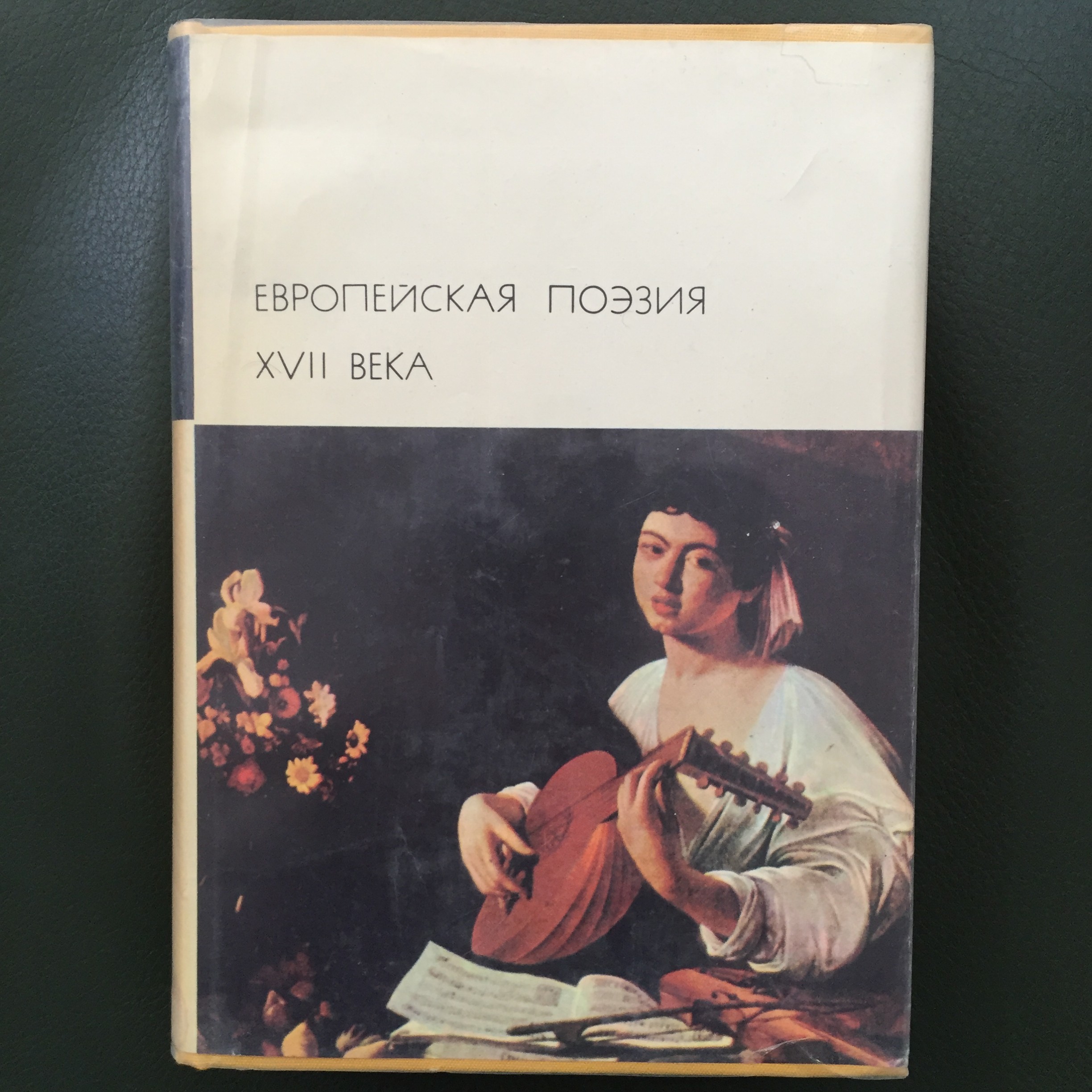
Европейская поэзия XVII века. Библиотека всемирной литературы. Серия первая. М.: Художественная литература, 1977. 928 с. Вступительная статья Ю. Виппера. Тир. 303 000.
-
 Seiro ehon nenju gyoji 青楼絵本年中行事 (A Picture Book of Annual Events in Yoshiwara). Block cut by: Fuji Kazumune (藤一宗). Printed by: Jakushodo Toemon (霍松堂藤右衛門). Written by: Jippensha Ikku (十返舎一九) (text, kyoka 4 & 12). Published by: Kazusaya Chusuke (上総屋忠助). Print artist: Kitagawa Utamaro (喜多川歌麿). Written by: Sandara Boshi (三陀羅法師) (kyoka 1). Workshop of: Yashiki no Katamaru (屋職堅丸). 1804 (spring); Edo. Reference: British Museum; Fine Arts Museums of San Francisco.
Seiro ehon nenju gyoji 青楼絵本年中行事 (A Picture Book of Annual Events in Yoshiwara). Block cut by: Fuji Kazumune (藤一宗). Printed by: Jakushodo Toemon (霍松堂藤右衛門). Written by: Jippensha Ikku (十返舎一九) (text, kyoka 4 & 12). Published by: Kazusaya Chusuke (上総屋忠助). Print artist: Kitagawa Utamaro (喜多川歌麿). Written by: Sandara Boshi (三陀羅法師) (kyoka 1). Workshop of: Yashiki no Katamaru (屋職堅丸). 1804 (spring); Edo. Reference: British Museum; Fine Arts Museums of San Francisco. -
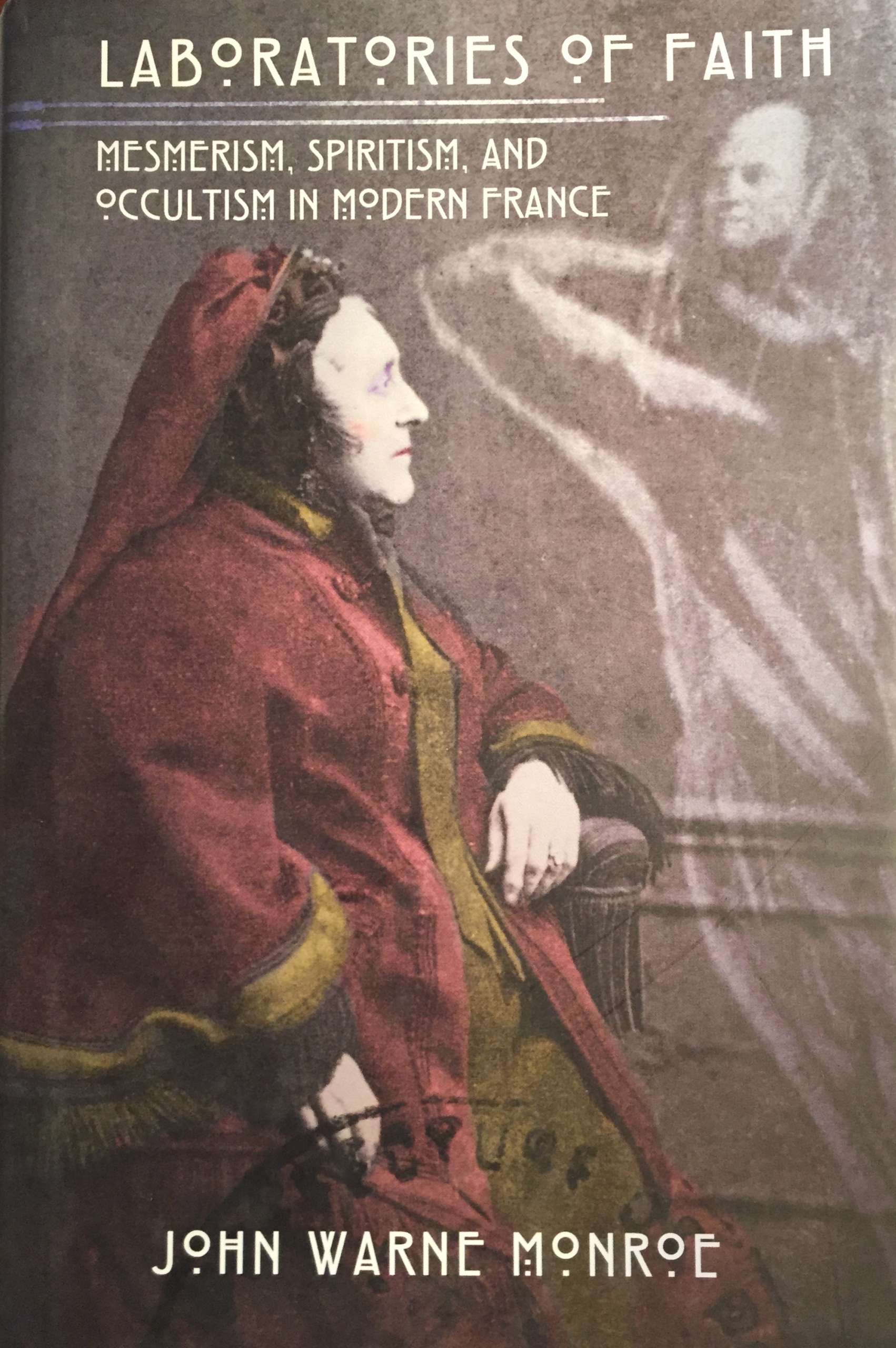
John Warne Monroe. Laboratories of Faith: Mesmerism, Spiritism, and Occultism in Modern France.
Cornel University Press, 2008.
ISBN: 9780801445620; Hardcover.
-
 Iron tsuba of round form with design of slanting rays of light (shakoh) or clock gear (tokei) in openwork (sukashi). Commonly considered a Christian / Jesuit motif. Round-cornered rim. Copper sekigane. Momoyama period: Late 16th century (Tensho/Keicho era). Height: 72.5 mm, Width: 72.2 mm, Rim thickness: 5.5 mm, Center thickness: 5.3 mm. Round-cornered rim. Provenance: Sasano collection. Sasano Masayuki, Japanese Sword Guards Masterpieces from The Sasano Collection, Part I, № 136: "The general belief that this design represents the gear of a clock is erroneous, rather it shows the slanting rays of light from a cross, with the small diamond shapes representing the upright and transverse bars. The Christian influence is obvious..."
Iron tsuba of round form with design of slanting rays of light (shakoh) or clock gear (tokei) in openwork (sukashi). Commonly considered a Christian / Jesuit motif. Round-cornered rim. Copper sekigane. Momoyama period: Late 16th century (Tensho/Keicho era). Height: 72.5 mm, Width: 72.2 mm, Rim thickness: 5.5 mm, Center thickness: 5.3 mm. Round-cornered rim. Provenance: Sasano collection. Sasano Masayuki, Japanese Sword Guards Masterpieces from The Sasano Collection, Part I, № 136: "The general belief that this design represents the gear of a clock is erroneous, rather it shows the slanting rays of light from a cross, with the small diamond shapes representing the upright and transverse bars. The Christian influence is obvious..." -
 Iron tsuba of round form decorated with eight roundels - circular emblems of flowers and/or family crests (mon) made of cast brass, pierced and chiseled in kebori, and with flat brass inlay (hira-zōgan) of vines or seaweed all over the plate. Hitsu-ana outlined in brass. Four positive silhouette roundels are 3-, 4-, 5-, and 6- pointing crests/flowers; four negative silhouette roundels are bellflower, cherry blossom, and suhama. Yoshirō school (Kaga-Yoshirō). The Momoyama or early Edo period, beginning of 17th century. Size: diameter 77 mm, thickness 3,8 mm
Iron tsuba of round form decorated with eight roundels - circular emblems of flowers and/or family crests (mon) made of cast brass, pierced and chiseled in kebori, and with flat brass inlay (hira-zōgan) of vines or seaweed all over the plate. Hitsu-ana outlined in brass. Four positive silhouette roundels are 3-, 4-, 5-, and 6- pointing crests/flowers; four negative silhouette roundels are bellflower, cherry blossom, and suhama. Yoshirō school (Kaga-Yoshirō). The Momoyama or early Edo period, beginning of 17th century. Size: diameter 77 mm, thickness 3,8 mm -
 A very large and very thin iron tsuba of round form decorated with design of formalized butterfly and dragonfly in openwork (sukashi). The characteristics of the plate resemble those of Kamakura period ko-tōshō tsuba. However, the design seems too 'modern' to me, but it's hard to tell; it may be a late Muromachi or Momoyama period work. Tōshō or Ko-Tōshō school (or a Katchushi). Muromachi period. Dimensions: 99.6 x 100.5 x 2.1 mm. This is what Jim Gilbert says about old tsuba:
A very large and very thin iron tsuba of round form decorated with design of formalized butterfly and dragonfly in openwork (sukashi). The characteristics of the plate resemble those of Kamakura period ko-tōshō tsuba. However, the design seems too 'modern' to me, but it's hard to tell; it may be a late Muromachi or Momoyama period work. Tōshō or Ko-Tōshō school (or a Katchushi). Muromachi period. Dimensions: 99.6 x 100.5 x 2.1 mm. This is what Jim Gilbert says about old tsuba:"Traditionally the old iron plate tsuba are classified into Ko Tosho (old sword smith), and Ko Katchushi (old armor maker) styles. It is sometimes difficult to justify attribution of a given tsuba to the Tosho or Katchushi category. Generally guards with raised rims or relatively complex designs tend to be assigned to Katchushi. This is basically a convention we follow out of habit and convenience." [...] "In Token Kai-Shi part six, Articles by Akiyama Kyusaku, Robert Haynes comments: "…from 1300 to 1400 over 150,000 MOUNTED swords were made in Japan for export alone. This means that over four tsuba a day were made for 100 years. This would mean that at least 3000 persons were making nothing but tsuba, let alone all the other fittings needed to complete these swords. With sword smiths, fittings makers and all the other artists need to complete a sword for export, at least 10,000 sword artists were working together, in any one of these hundred years."
Reference to design can be found at "Japanese Swords and Tsuba from the Professor A. Z. Freeman and the Phyllis Sharpe Memorial collections" / Sotheby's, London, Thursday 10 April 1997; p. 18-19, lot № 37: "A Kamakura-bori Tsuba, Momoyama Period. ...pierced with two large formalised butterflies..."Reference to design in this collection: TSU-0319.
A Kamakura-bori tsuba of octagonal form, Momoyama period.

TSU-0319. Ōnin ten-zōgan tsuba, Muromachi period.
-

Iron tsuba of oval form with the design of two immortals (Gama Sennin with the toad upon his head and Tekkai Sennin with his iron crutch) beside a waterfall carved in low relief with a high relief effect (takabori) and with details inlaid in gold. A waterfall carved on the reverse. Nakago-ana is plugged with copper sekigane. Unsigned. Allegedly, Mito School.
Edo period, ca. 1700.
Size: Height: 87.0 mm; Width: 82.8 mm; Thickness: 4.4 mm; Weight: 179 g.
No longer available. -

Iron tsuba of round form inlaid with brass and shakudo (suemon-zōgan) with a design of tendrils, leaves, double gourds, and folding fan with two wild geese on the face and the same design only with a fan with two interlocked rings (wachigai) on the back. Design is supplemented with a round family crest (mon) of three fans in openwork (sukashi). Hitsu-ana and the mon are outlined with brass rope. Copper sekigane.
Some attribute such tsuba as belonging to Heianjō or even Yoshirō School, and date them to Momoyama period. I keep this piece under Ōnin rubric, late Muromachi, but this is just a question of personal preference.Some inlay is missing, some repaired; traces of rust. Otherwise - decent condition.
Late Muromachi period (1514-1573). Size: 77.4 x 77.1 x 3.8 (center), 3.2 (rim) mm -

Classical picklock bayonet switchblade knife with bolster release, fixed guard, cream handles (ivory?).
Size: 123 mm x 20 mm (closed); 220 mm (opened); 130 mm blade.
Tang is etched with: Havlin. -

Iron tsuba of round form pierced (sukashi) and inlaid in flat (hira-zōgan) and cast brass (suemon-zōgan), details carved in kebori, with design of two phoenixes, bamboo, and paulownia leaves and flowers (kiri-mon) on both sides. According to seller: Bizen-Yoshirō school (or Heianjō school). Unsigned.
Momoyama period. End of the 16th - beginning of the 17th century. Dimensions: Diameter: 99.5 mm; Thickness: 2.1 mm at centre; 4.3 mm at the rim. According to Merrily Baird (Symbols of Japan), "bamboo teamed with paulownia blossoms or with paulownia and the phoenix, in reference to the Chinese legend that the phoenix perches only on the paulownia and eats only the bamboo". Citation from http://www.clevelandart.org/art/1986.2.1: "The immense heraldic birds on display [...] reflect the Momoyama era's spirit of newly gained self-confidence and an affinity for grand expressive statements in painting, architecture, the textile and ceramic arts, as well as garden design. While that period preceded the arrival of prosperity, it clearly marked an extraordinary moment in Japanese cultural history, one frequently compared with the twelfth century of the Heian period. [...] Rather than an emblem of immortality, as it is in Western lore, in Japan, the phoenix evolved out of its origins in Chinese mythology to become, by the sixteenth century, an auspicious symbol of political authority. Together with clusters of the distinctively shaped paulownia leaves, this long-tailed, mythical bird [...] proclaiming an air of graceful command". -
 Iron tsuba of round form adorned with the design of stars, wild geese, floating blossoms, leaves and tendrils realized in brass inlay. The inlay technique includes suemon-zōgan and ten-zōgan. Two smaller openings (hitsu-ana) surrounded by a scalloped brass border. The seppa-dai border inlay is missing, as well as a few other fragments of inlay on both sides. Sword cut at 12 o'clock on the reverse. A tsuba with a strong autumnal connotation, which once belonged to a great battle weapon. One of only three known jūyō Ōnin tsuba. Translation of the paper, issued by the Japanese sword fittings (tosogu) examination board: Designated as jūyō-tosogu at the 34th jūyō-shinsa held on April 14th 1988 Kaki-karimon zōgan-tsuba (花卉雁文象嵌鐔) — Tsuba with zōgan design of flowers and wild geese. Mumei: Onin (応仁) Tokyo. Nakasono Tokumi (中園とくみ) Measurements: height 9.5 cm, width 9.4 cm, thickness at rim 0.35 cm Interpretation: marugata, iron, brass zōgan, two hitsu-ana Time: end of Muromachi Explanation: Ōnin-tsuba are thin iron ita-tsuba which show a brass zōgan ornamentation. All of them are mumei and there is the theory that they were made in the Onin era (1467-1469) although today more and more the theory is accepted that they are in general late Muromachi period works. There are two kinds of brass zōgan interpretations: One depicts irregularly arranged tachibana branches, wild geese, chrysanthemums, flowers, or karakusa for example, and the other one shows punctual zōgan elements, which are referred to as hoshi-zōgan or ro-zōgan, and concentrical zōgan elements between the nakago-ana and the rim. The latter interpretations might also be accompanied by simple ko-sukashi in the form of butterflies, clouds, hats, or stylized mountains. This tsuba is a typical work from the former category. It is large and feels massive and the powerful and impressive zōgan and the excellent iron make it a highly tasteful piece. Back side: Issued to: Nakasono Tokumi Address: Tokyo-to, Suginami-ku, Kamitakaido 2-17-26 Date of issue: May 30th 1989
Iron tsuba of round form adorned with the design of stars, wild geese, floating blossoms, leaves and tendrils realized in brass inlay. The inlay technique includes suemon-zōgan and ten-zōgan. Two smaller openings (hitsu-ana) surrounded by a scalloped brass border. The seppa-dai border inlay is missing, as well as a few other fragments of inlay on both sides. Sword cut at 12 o'clock on the reverse. A tsuba with a strong autumnal connotation, which once belonged to a great battle weapon. One of only three known jūyō Ōnin tsuba. Translation of the paper, issued by the Japanese sword fittings (tosogu) examination board: Designated as jūyō-tosogu at the 34th jūyō-shinsa held on April 14th 1988 Kaki-karimon zōgan-tsuba (花卉雁文象嵌鐔) — Tsuba with zōgan design of flowers and wild geese. Mumei: Onin (応仁) Tokyo. Nakasono Tokumi (中園とくみ) Measurements: height 9.5 cm, width 9.4 cm, thickness at rim 0.35 cm Interpretation: marugata, iron, brass zōgan, two hitsu-ana Time: end of Muromachi Explanation: Ōnin-tsuba are thin iron ita-tsuba which show a brass zōgan ornamentation. All of them are mumei and there is the theory that they were made in the Onin era (1467-1469) although today more and more the theory is accepted that they are in general late Muromachi period works. There are two kinds of brass zōgan interpretations: One depicts irregularly arranged tachibana branches, wild geese, chrysanthemums, flowers, or karakusa for example, and the other one shows punctual zōgan elements, which are referred to as hoshi-zōgan or ro-zōgan, and concentrical zōgan elements between the nakago-ana and the rim. The latter interpretations might also be accompanied by simple ko-sukashi in the form of butterflies, clouds, hats, or stylized mountains. This tsuba is a typical work from the former category. It is large and feels massive and the powerful and impressive zōgan and the excellent iron make it a highly tasteful piece. Back side: Issued to: Nakasono Tokumi Address: Tokyo-to, Suginami-ku, Kamitakaido 2-17-26 Date of issue: May 30th 1989 -
 Utagawa Kunisada (Japanese: 歌川 国貞; also known as Utagawa Toyokuni III (三代歌川豊国); 1786 – 12 January 1865).
Utagawa Kunisada (Japanese: 歌川 国貞; also known as Utagawa Toyokuni III (三代歌川豊国); 1786 – 12 January 1865).A man with a shaved head (a monk), holding a paper lantern and an umbrella, walks with a young woman (a geisha) in the rain.
SIGNED: Gototei Kunisada ga [五渡亭国貞画]
Censor's seals: kiwame, futakata.
Blockcutter's mark: Seizô tô [改印:極、貳方]
MFA ACCESSION NUMBER 11.15150; MFA dating: about 1815–21 (Bunka 12–Bunsei 4);
Size: Vertical Ōban (382 x 260 mm). SOLD -
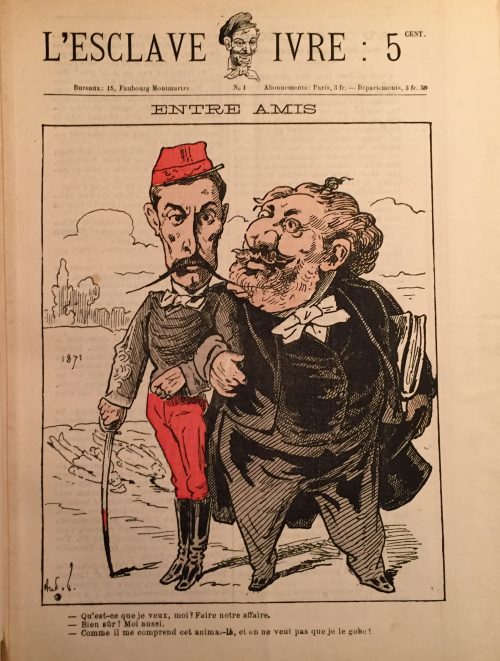 Artist: André Gill [real name Louis-André Gosset] (French, 1840 – 1885). L'Esclave Ivre [The Drunken Slave] was a Parisian weekly, published in 1881, 4 issues total. Léon Gambetta (French, 1838 – 1882) stands arm in arm with Marshal Patrice de MacMahon (French, 1808 – 1893). Dead bodies of communards lie in the midground and a landscape is faintly perceived in the background. 1871 is written on the hill on the left. L'Esclave Ivre, Issue 1. Entre Amis. Text below the image: - Qu'est-ce que je veux, moi? Faire notre affaire. / - Bien sûr! Moi aussi. / - Comme il me comprend cet animal-là, et on ne veut pas que je le gobe! [In between friends / - What do I want? To make a deal. / - Of course! Me too. / - How well this animal understands me, and we do not want me to swallow him!]
Artist: André Gill [real name Louis-André Gosset] (French, 1840 – 1885). L'Esclave Ivre [The Drunken Slave] was a Parisian weekly, published in 1881, 4 issues total. Léon Gambetta (French, 1838 – 1882) stands arm in arm with Marshal Patrice de MacMahon (French, 1808 – 1893). Dead bodies of communards lie in the midground and a landscape is faintly perceived in the background. 1871 is written on the hill on the left. L'Esclave Ivre, Issue 1. Entre Amis. Text below the image: - Qu'est-ce que je veux, moi? Faire notre affaire. / - Bien sûr! Moi aussi. / - Comme il me comprend cet animal-là, et on ne veut pas que je le gobe! [In between friends / - What do I want? To make a deal. / - Of course! Me too. / - How well this animal understands me, and we do not want me to swallow him!] -
![[ROSCOE, Thomas, translator]. Tales of Humour, Gallantry, & Romance, selected and translated from the Italian. With sixteen illustrative Drawings by George Cruikshank. London, Printed for Charles Baldwyn, 1827.](https://varshavskycollection.com/wp-content/uploads/2021/02/LIB-1079-2-500x839.jpg) Title: TALES | OF | Humour, Gallantry, & Romance, | SELECTED AND TRANSLATED | FROM THE ITALIAN. | Vignette "The Elopement, p. 183" | With sixteen illustrative Drawings by George Cruikshank. | — | LONDON : | PRINTED FOR CHARLES BALDWYN, | NEWGATE STREET. | MDCCCXXVII. Pagination: [2], [v]-vi [2] – Contents (Cohn's collation calls for this at the end) 3-253, [1]; title-page a cancel with vignette 'The Elopment', sixteen other plates by Cruikshank; as per HathiTrust: vi, 253, [3] p. (last p. blank), [16] leaves of plates: ill. Binding: 8vo, 20 x 13 cm, later polished calf, gilt, t.e.g. others untrimmed, by Rivière for H. Sotheran. Note: 1st edition, very rare 3rd issue, with a cancel title-page replacing that of 1824 issue when there were two issues and the work was entitled Italian Tales. Cohn notes the rarity of the 1827 edition, which restores one of the plates 'The Dead Rider', suppressed in the second issue, and also includes the plate done to replace it. "The rarest edition of this work is that published in 1827 in green paper boards [...]. This issue has no edition stated on the title. It has seventeen woodcuts, inclusive of the "Elopement" vignette upon the title. The suppressed plate "The Dear Rider" is restored, and the plate done to replace it is also included. The woodcut in other editions upon the title page is "The Pomegranate Seed". Probably compiled and translated by Thomas Roscoe (cf. National union catalog) from a variety of authors 'out of materials not generally accessible', but also ascribed to J. Y. Akerman and to one "Southern". Two or three tales that furnished plots for Shakespeare. Catalogue Raisonné: Cohn 444; this issue not found in OCLC or COPAC.
Title: TALES | OF | Humour, Gallantry, & Romance, | SELECTED AND TRANSLATED | FROM THE ITALIAN. | Vignette "The Elopement, p. 183" | With sixteen illustrative Drawings by George Cruikshank. | — | LONDON : | PRINTED FOR CHARLES BALDWYN, | NEWGATE STREET. | MDCCCXXVII. Pagination: [2], [v]-vi [2] – Contents (Cohn's collation calls for this at the end) 3-253, [1]; title-page a cancel with vignette 'The Elopment', sixteen other plates by Cruikshank; as per HathiTrust: vi, 253, [3] p. (last p. blank), [16] leaves of plates: ill. Binding: 8vo, 20 x 13 cm, later polished calf, gilt, t.e.g. others untrimmed, by Rivière for H. Sotheran. Note: 1st edition, very rare 3rd issue, with a cancel title-page replacing that of 1824 issue when there were two issues and the work was entitled Italian Tales. Cohn notes the rarity of the 1827 edition, which restores one of the plates 'The Dead Rider', suppressed in the second issue, and also includes the plate done to replace it. "The rarest edition of this work is that published in 1827 in green paper boards [...]. This issue has no edition stated on the title. It has seventeen woodcuts, inclusive of the "Elopement" vignette upon the title. The suppressed plate "The Dear Rider" is restored, and the plate done to replace it is also included. The woodcut in other editions upon the title page is "The Pomegranate Seed". Probably compiled and translated by Thomas Roscoe (cf. National union catalog) from a variety of authors 'out of materials not generally accessible', but also ascribed to J. Y. Akerman and to one "Southern". Two or three tales that furnished plots for Shakespeare. Catalogue Raisonné: Cohn 444; this issue not found in OCLC or COPAC.


